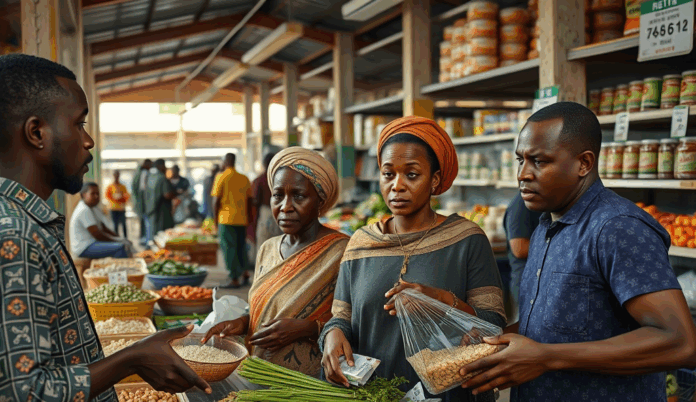Introduction: Understanding the Impact of Inflation on Nutrition in Nigeria
Nigeria’s inflation rate hit 28.9% in December 2023, with food prices rising even faster at 33.9%, according to the National Bureau of Statistics. This sharp increase has forced many families to compromise on nutritional quality as staple foods like rice, beans, and vegetables become less affordable.
The food affordability crisis in Nigeria has led to worrying malnutrition trends, particularly among children and low-income households. For instance, UNICEF reports that 37% of Nigerian children under five suffer from stunting due to inadequate diets exacerbated by rising food prices.
As inflation-driven dietary changes push families toward cheaper, less nutritious options, the long-term health implications grow more severe. The next section will explore how these rising costs directly impact Nigerian families’ daily meals and budgeting strategies.
Key Statistics

The Rising Cost of Food: How Inflation Affects Nigerian Families
Nigeria’s inflation rate hit 28.9% in December 2023 with food prices rising even faster at 33.9% according to the National Bureau of Statistics.
With food inflation at 33.9%, Nigerian families now spend over 60% of their income on meals, forcing painful trade-offs between quantity and nutrition. A Lagos market survey shows the price of a 50kg bag of rice doubled within a year, pushing protein sources like eggs and fish beyond reach for many households.
Low-income families increasingly rely on carb-heavy diets, with 68% cutting back on fruits and vegetables according to a recent NOIPolls survey. This shift mirrors national malnutrition trends where children’s school meals now feature fewer nutrient-dense foods like beans or leafy greens.
As budgeting strategies prioritize affordability over quality, the next section examines which essential nutrients suffer most in inflation-driven diets.
Essential Nutrients and Their Importance for Nigerian Families
With food inflation at 33.9% Nigerian families now spend over 60% of their income on meals forcing painful trade-offs between quantity and nutrition.
As inflation forces Nigerian households toward carb-heavy diets, critical nutrient gaps emerge, particularly in protein, iron, and vitamin A—nutrients abundant in now-unaffordable foods like eggs, fish, and leafy greens. The National Bureau of Statistics reports 42% of Nigerian children under five suffer vitamin A deficiency, worsening as families substitute rice for more nutritious but costly alternatives.
Protein scarcity hits hardest, with UNICEF data showing 45% of Nigerian children experience stunted growth due to insufficient intake, compounded by the 120% price surge for beans—a traditional protein source. Iron deficiency also rises sharply, particularly among pregnant women relying on less nutritious staples like garri instead of iron-rich meats or vegetables.
These nutritional shortfalls directly impact cognitive development and immunity, creating long-term health costs that outweigh short-term food savings. The next section explores affordable protein alternatives to help families mitigate these deficiencies despite rising food prices in Nigeria.
Budget-Friendly Protein Sources for Nigerian Households
Despite the 120% price surge in beans Nigerian families can still access affordable protein through underutilized options like groundnuts and soybeans which provide 26g and 36g of protein per 100g respectively at half the cost of meat.
Despite the 120% price surge in beans, Nigerian families can still access affordable protein through underutilized options like groundnuts and soybeans, which provide 26g and 36g of protein per 100g respectively at half the cost of meat. Local markets offer nutrient-dense alternatives such as crayfish (45% protein content) and locust beans (iru), which maintain cultural relevance while addressing malnutrition trends during inflation in Nigeria.
Poultry byproducts like chicken feet and gizzards deliver comparable protein to premium cuts at 30-40% lower prices, particularly valuable for households facing food affordability crises. Research shows that incorporating just 50g of these daily meets 25% of children’s protein needs, directly countering the stunted growth affecting 45% of Nigerian children mentioned earlier.
For vegetarians, fermented foods like ogiri and ugba retain up to 20g protein per serving while enhancing iron absorption—critical for pregnant women shifting from iron-rich meats. These traditional solutions demonstrate how strategic food choices can mitigate nutritional deficiencies amid inflation, paving the way for exploring affordable carbohydrate options next.
Affordable Carbohydrate Options to Sustain Energy Levels
Leveraging bulk purchases during seasonal harvests can reduce costs by 30-50% especially for durable staples like dried fish or grains which align with Nigeria’s food affordability crisis.
Complementing the protein-rich alternatives discussed earlier, Nigerian families can prioritize cost-effective carbohydrates like unripe plantains (50% cheaper than rice) and sweet potatoes, which provide 30g of complex carbs per 100g while stabilizing blood sugar. Research shows these staples meet 40% of daily energy needs at just ₦200 per meal, crucial for households navigating rising food prices in Nigeria.
Local options like garri (cassava flakes) offer versatility at ₦150 per cup, delivering 360 calories with longer shelf life—ideal for inflation-driven dietary changes. When paired with protein sources like crayfish or locust beans mentioned earlier, these combinations create balanced meals addressing both energy deficits and malnutrition trends during inflation.
For budget-conscious families, millet and sorghum provide iron-rich carbohydrate alternatives at 20% lower cost than imported grains, directly tackling food affordability crises. These indigenous grains transition naturally into exploring nutrient-dense vegetables, which we’ll examine next for maximizing nutrition on limited budgets.
Local and Seasonal Vegetables: Maximizing Nutrition on a Budget
While rising food prices in Nigeria continue to strain household budgets strategic meal planning and local food substitutions can help families maintain balanced nutrition.
Building on the cost-effective staples discussed earlier, Nigerian families can further optimize nutrition by prioritizing local vegetables like ugu (fluted pumpkin) and waterleaf, which provide essential vitamins at 60% lower cost than imported greens. Studies show these leafy vegetables deliver 25% of daily folate requirements per 100g serving while costing just ₦100 per bunch—critical for addressing malnutrition trends during inflation.
Seasonal options like okra and bitter leaf offer additional affordability, with prices dropping 40% during peak harvest periods while retaining iron and vitamin C content. When paired with previously mentioned protein sources like crayfish or locust beans, these vegetables create nutrient-dense soups that combat food affordability crises without sacrificing dietary quality.
For maximum budget efficiency, families should prioritize vegetables with longer shelf lives like dried onions or fermented ogiri, which retain 80% of nutrients while reducing waste—a practical transition to exploring smart shopping strategies for stretching limited food budgets.
Smart Shopping Tips to Stretch Your Food Budget During Inflation
Leveraging bulk purchases during seasonal harvests can reduce costs by 30-50%, especially for durable staples like dried fish or grains, which align with Nigeria’s food affordability crisis. Market surveys show evening purchases at local markets often yield discounts of 15-20% as vendors clear perishables like tomatoes and peppers before closing.
Prioritizing neighborhood cooperatives for group buying unlocks wholesale prices, with families reporting 40% savings on items like beans and garri compared to retail prices. Digital tools like price-tracking apps help identify the cheapest vendors for seasonal produce, mitigating inflation-driven dietary changes.
Strategic substitutions—like using affordable unripe plantains instead of rice—maintain calorie intake while cutting costs by 60%, creating a natural bridge to meal planning strategies. Preserving seasonal surpluses through sun-drying or fermentation extends shelf life, mirroring earlier recommendations for nutrient retention.
Meal Planning Strategies for Nutritious and Cost-Effective Meals
Building on strategic substitutions like unripe plantains, weekly meal plans incorporating seasonal produce can reduce grocery expenses by 25% while ensuring balanced nutrition. For example, pairing affordable protein sources like beans with vitamin-rich leafy vegetables creates nutrient-dense meals that combat malnutrition trends during inflation in Nigeria.
Batch cooking staple dishes like jollof rice with bulk-purchased ingredients maximizes time and cost efficiency, with families saving up to 40% compared to daily cooking. Preserved seasonal surpluses, such as sun-dried tomatoes or fermented locust beans, add flavor and nutrients to meals while aligning with earlier food preservation tips.
Digital tools like meal-planning apps help track inventory and minimize waste, naturally transitioning to the next section on reducing food waste. This approach ensures families maintain household food security despite rising food prices in Nigeria.
Reducing Food Waste to Save Money and Maintain Nutrition
Complementing digital inventory tracking mentioned earlier, Nigerian families can repurpose leftovers creatively to cut food waste by 30%, as shown in Lagos State waste audits. Overripe plantains make nutritious pancakes, while vegetable scraps enrich homemade soups, preserving nutrients that combat malnutrition trends during inflation in Nigeria.
Proper storage extends shelf life significantly, with airtight containers keeping garri fresh for 6 months and refrigeration preserving leafy greens for 2 extra weeks. These methods align with earlier preservation techniques like sun-drying tomatoes, creating a comprehensive approach to household food security challenges in Nigeria.
Community sharing initiatives, where neighbors exchange surplus harvests, demonstrate how collective action amplifies individual efforts against rising food prices in Nigeria, naturally leading to discussions about government-supported nutritional programs. This bridges to examining larger-scale solutions for the food affordability crisis in Nigeria.
Community Support and Government Programs for Nutritional Aid
Building on grassroots efforts like neighborhood food sharing, Nigeria’s National Social Investment Programme (NSIP) provides school feeding programs reaching 9.9 million children daily, directly addressing malnutrition trends during inflation. State-level initiatives like Lagos Food Bank distribute nutrient-rich packs to vulnerable households, complementing household food security strategies discussed earlier.
Federal interventions include subsidized fertilizer programs boosting local crop yields by 20%, helping farmers counter rising food prices in Nigeria while improving community nutrition. These systemic solutions work alongside individual preservation techniques, creating layered defenses against the food affordability crisis in Nigeria.
As families combine these approaches with earlier discussed methods like creative repurposing and proper storage, they build resilience against economic pressures—setting the stage for concluding strategies to stay healthy despite financial constraints.
Conclusion: Staying Healthy Despite Economic Challenges
While rising food prices in Nigeria continue to strain household budgets, strategic meal planning and local food substitutions can help families maintain balanced nutrition. As discussed earlier, prioritizing protein-rich beans over expensive meats and incorporating seasonal vegetables like ugu and waterleaf can reduce costs without compromising health.
Government interventions for food inflation in Nigeria, such as the recent subsidy on fortified staples, provide temporary relief but require long-term solutions. Families should combine these measures with home gardening initiatives, as seen in Lagos urban farming projects, to supplement their diets affordably.
The impact of inflation on Nigerian diets remains significant, yet adaptable approaches can mitigate nutritional deficiencies. By applying these practical strategies consistently, households can navigate the food affordability crisis while preserving their health.
Frequently Asked Questions
How can Nigerian families afford protein-rich foods during nutrition inflation?
Opt for budget-friendly protein sources like groundnuts soybeans and crayfish which provide comparable nutrition at half the cost of meat.
What are the most affordable carbohydrate options to replace expensive rice?
Unripe plantains and sweet potatoes offer complex carbs at 50% lower cost while providing sustained energy for Nigerian families.
Can we maintain proper nutrition while cutting food costs during inflation?
Yes prioritize local seasonal vegetables like ugu and waterleaf which deliver essential vitamins at 60% lower cost than imported greens.
How can Nigerian households reduce food waste to stretch their budgets?
Repurpose leftovers creatively and use airtight storage to extend shelf life cutting waste by 30% according to Lagos State audits.
Are there government programs helping families cope with nutrition inflation?
Yes Nigeria's NSIP school feeding program reaches 9.9 million children daily while state food banks distribute nutrient packs to vulnerable households.


